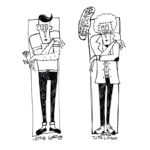
by Giovanni Ballarini
9 The abstract maker sees just a tiny plot behind a dish, a lunch or a restaurant a plot which he can see clearly. This plot is – based on his or the place actual conditions – historical, sociological, anthropological, and so on, and can mean many things, but without reaching any true and useful conclusions for the average client. The abstract-maker believes this plot explains everything, but does not allow judgment, setting him apart from the other kinds of food critics.
10 – The spin doctor is the least definable of them all, in that, while talking about everything from the dish to the menu, the restaurant and all that there is around, often or almost always does not say anything, but he says it very well. Therefore it is often invited to speak, because he knows how to dress properly and never badmouths, which grant him success and social life.
What other types of food critic exist? Many others, from the ill-mannered, or aggressive, to the verbal-nastiness-state-of-the-art (who is kind and mild once seated), or the mild, or persuasive, verging on the oily, and let’s not forget the hidden who carefully hides from any and everyone but some fortunate few who can say “I know who he is, but I can’t tell you who he is”. Everyone, according to their personal experience, can also add other types and varieties of food critics, or change the examples we wanted to give. But there’s – or there could be- another problem, one which is very difficult and perhaps impossible: how should a food critic work? In other words, what is this critic useful for and who should it be useful to? To fry and find an answer we should, just like they do in the art critic field at large (see quoted Roberto Escobar), turn back to the beginning, not only of food critics but of cooking itself, when primitive men, eating food cooked or just given him by his wife, expressed a “good” or “not good” judgment as well as a substantial one. Let us not forget that on one of the first written texts, the Bible, good food is defined as having a rich sauce, as being “juicy” (Job 36,13 – Isaiah 25.6 – Isaiah 55.2 – Habakkuk 1, 16).
The food critic, apart from his personal history {perhaps of little interest to most} should never forget the pleasure of eating in all its aspects, starting with the conviviality, not always favored in many public places too noisy, too crowded and crammed (fortunately now no longer foggy with smoke), with the freedom that everyone, even at the table, he wants to play as and, also, how can within their means.
Continues…
Drawings by Cecilia Mistrali
 English
English  Italiano
Italiano 





